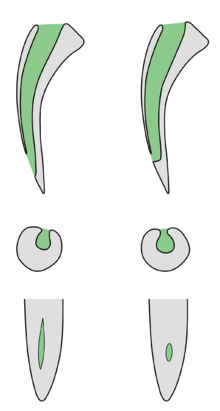Spitting cobra

Spitting cobras on the right.
1: Section of the whole fang in the sagittal plane.
2: Horizontal section through the fang at the discharge orifice.
3: Frontal view of the discharge orifices.



A spitting cobra is any of several species of cobras that can defensively project venom from their fangs into the eyes of an attacker.
Venom[]
The spat venom is generally harmless on intact mammalian skin (although contact can result in delayed blistering of the area), but can cause permanent blindness if introduced to the eye; if left untreated it may cause chemosis and corneal swelling.
The venom sprays out in distinctive geometric patterns when muscles squeeze the glands to squirt it out through forward-facing holes near the tips of the fangs.[1] Individuals of some species of spitting cobras make hissing exhalations/lunging movements of their heads when "spitting" from the tongue, and it has been argued that such actions assist in propelling the venom, but research does not support the hypothesis that they play any major functional part except possibly enhancing the threatening effect of the behaviour.[2][3] When cornered, some species "spit" their venom as far as 2 m (6.6 ft).[4] While spitting typically is their primary form of defense, all spitting cobras also can deliver venom by biting.
Most spitting cobras' venoms are significantly cytotoxic, apart from the neurotoxic and cardiotoxic effects typical of other cobra species. The ability to spit venom evolved in cobras three times independently through convergent evolution.[4] In each of these three cases the venom convergently evolved to be more effective at creating pain in mammals to serve as a better deterrent.[5]
Species[]
African:
- Hemachatus haemachatus
- Naja ashei
- Naja katiensis
- Naja mossambica
- Naja nigricincta
- Naja nigricollis
- Naja nigricincta woodi
- Naja crawshayi
- Naja nubiae
- Naja pallida
Asiatic:
- Naja atra
- Naja kaouthia
- Naja sagittifera
- Naja mandalayensis
- Naja philippinensis
- Naja samarensis
- Naja siamensis
- Naja sputatrix
- Naja sumatrana
Other spitting snakes[]
Some of the Viperidae have been reported to spit occasionally.[6]
References[]
- ^ Young, B. A.; Dunlap, K.; Koenig, K.; Singer, M. (September 2004). "The buccal buckle: The functional morphology of venom spitting in cobras". Journal of Experimental Biology. 207 (20): 3483–3494. doi:10.1242/jeb.01170. PMID 15339944.
- ^ Berthé, Ruben Andres. Spitting behaviour and fang morphology of spitting cobras. Doctoral thesis, Rheinischen Friedrich-Wilhelms-Universität, Bonn, April 2011.
- ^ Rasmussen, Sara; Young, B.; Krimm, Heather (September 1995). "On the 'spitting' behaviour in cobras (Serpentes: Elapidae)". Journal of Zoology. 237 (1): 27–35. doi:10.1111/j.1469-7998.1995.tb02743.x.
- ^ a b Panagides, Nadya; Jackson, Timothy N. W.; Ikonomopoulou, Maria P.; Arbuckle, Kevin; Pretzler, Rudolf; Yang, Daryl C.; Ali, Syed A.; Koludarov, Ivan; Dobson, James; Sanker, Brittany; Asselin, Angelique (2017-03-13). "How the Cobra Got Its Flesh-Eating Venom: Cytotoxicity as a Defensive Innovation and Its Co-Evolution with Hooding, Aposematic Marking, and Spitting". Toxins. 9 (3): E103. doi:10.3390/toxins9030103. ISSN 2072-6651. PMC 5371858. PMID 28335411.
- ^ Kazandjian, T. D.; Petras, D.; Robinson, S. D.; van Thiel, J.; Greene, H. W.; Arbuckle, K.; Barlow, A.; Carter, D. A.; Wouters, R. M.; Whiteley, G.; Wagstaff, S. C.; Arias, A. S.; Albulescu, L.-O.; Plettenberg Laing, A.; Hall, C.; Heap, A.; Penrhyn-Lowe, S.; McCabe, C. V.; Ainsworth, S.; da Silva, R. R.; Dorrestein, P. C.; Richardson, M. K.; Gutiérrez, J. M.; Calvete, J. J.; Harrison, R. A.; Vetter, I.; Undheim, E. A. B.; Wüster, W.; Casewell, N. R. (2021). "Convergent evolution of pain-inducing defensive venom components in spitting cobras" (PDF). Science. 371 (6527): 386–390. doi:10.1126/science.abb9303. ISSN 0036-8075. PMC 7610493.
- ^ Wüster, Wolfgang; Thorpe, Roger S. (December 1992). "Dentitional phenomena in cobras revisited: Spitting and fang structure in the Asiatic species of Naja (Serpentes: Elapidae)" (PDF). Herpetologica. 48 (4): 424–434. JSTOR 3892862.
- Greene, Harry W. (1997) Snakes: The Evolution of Mystery in Nature. University of California Press, Berkeley and Los Angeles, California.
External links[]
| Wikimedia Commons has media related to Spitting cobras. |
- Video of an African red spitting cobra spraying its venom
- Video of an African red spitting cobra feeding
- Discovery News 'Spitting Cobras' Sharp-Shooting Secrets"
- Elapidae
- Snakes of Africa
- Reptiles of Asia